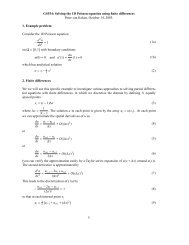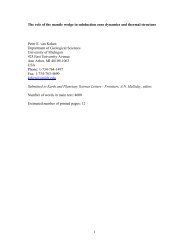Quantitative paleoenvironmental and paleoclimatic reconstruction ...
Quantitative paleoenvironmental and paleoclimatic reconstruction ...
Quantitative paleoenvironmental and paleoclimatic reconstruction ...
You also want an ePaper? Increase the reach of your titles
YUMPU automatically turns print PDFs into web optimized ePapers that Google loves.
ARTICLE IN PRESS<br />
14 N.D. Sheldon, N.J. Tabor / Earth-Science Reviews xxx (2009) xxx–xxx<br />
Fig. 9. Mass-balance of major <strong>and</strong> trace elements. Ca <strong>and</strong> Na are lost throughout the profiles, whereas both K <strong>and</strong> Rb were added.<br />
pedogenesis. The equation for delineating pedogenesis from addition<br />
is:<br />
Δ P = τ K − τ Rb<br />
ð13Þ<br />
where Δ P is the change in K due to pedogenesis. Fig. 10 shows Δ P<br />
values as a function of depth in the same paleosol in Fig. 9B. The<br />
adjusted K loss is now similar to that of Na, another alkali element,<br />
which is similar to the pattern observed in modern basalt-parented<br />
soils (Chadwick et al., 1999). Thus, mass balance may be used to<br />
differentiate between different pedogenic processes <strong>and</strong> sources of<br />
elemental additions <strong>and</strong> losses.<br />
The obvious limitation to applying any type of mass balance<br />
calculation is being able to demonstrate that one or more elements<br />
was immobile or nearly immobile during weathering. Because true<br />
immobility is unlikely, the relative degree of immobility is important.<br />
ε i,w values of ±0.4 indicate limited mobility, but ideally, unless<br />
there is a strong basis for inferring addition or removal by physical<br />
weathering processes, values closer to 0 are preferable. For example,<br />
when volcanic rocks weather, many of the mafic minerals (e.g.,<br />
olivine, pyroxene, plagioclase feldspar) chemically weather readily<br />
under most pH conditions, whereas rutile (TiO 2 ) will only be removed<br />
by physical weathering except at very acidic pH conditions.<br />
Thus, addition of Ti 4+ is unsurprising in that case <strong>and</strong> the relative<br />
degree of enrichment will in fact be tracking pedogenesis, <strong>and</strong> at<br />
least indirectly, giving weathering intensity. If on the other h<strong>and</strong> ε Ti,w<br />
is less than 0 in the same setting, that suggests that some erosion of<br />
the paleosol has taken place or that there has been downprofile<br />
translocation of the Ti-bearing minerals. Distinguishing between<br />
those processes is key to underst<strong>and</strong>ing how that paleosol<br />
developed. Therefore, care is needed in selecting <strong>and</strong> testing<br />
“immobile” elements to ensure that they truly represent pedogenic<br />
immobility.<br />
The other factor that is important in considering mass balance<br />
results is the role that formation time plays. Short duration, intense<br />
weathering may result in similar elemental gains <strong>and</strong> losses as long<br />
duration, low intensity weathering. Tightly constraining formation<br />
times for paleosols, in particular for pre-Quaternary paleosols, is very<br />
difficult, though a few methods have been proposed that are independent<br />
of chemical composition (cf. Sections 5.2.3–5.2.4; Birkel<strong>and</strong>,<br />
1999; Retallack, 2001a,b; Sheldon, 2003; Retallack, 2005b). For<br />
example, Sheldon (2003) used data from Markewich et al. (1990) to<br />
propose the following relationship relating formation time (T f in<br />
years) to Bt horizon thickness (T Bt ):<br />
where R 2 =0.87, no error function was calculated because the relation<br />
falls apart for very long-formation times. Retallack (2005b) did<br />
something similar for Bk horizons where he found a relationship<br />
between soil age (A in Ka) <strong>and</strong> nodule size (S in cm):<br />
A = 3:92S 0:34<br />
ð15Þ<br />
where R 2 =0.57 <strong>and</strong> the st<strong>and</strong>ard error is 1.8 Ka. While these<br />
chronofunctions hold some promise for paleosols with either Bt or<br />
Bk horizons, they are both based on relatively few data (n=10 for<br />
Sheldon, 2003; n=9 for Retallack, 2005b) <strong>and</strong> many soil/paleosols<br />
types lack those particular horizons. Semi-quantitative relationships<br />
discussed in Birkel<strong>and</strong> (1999) also offer some promise for at least<br />
making appropriate order-of-magnitude age estimates, but significantly<br />
more work is needed in this area.<br />
5.3.2. Precambrian atmospheric CO 2 from mass balance<br />
Because Precambrian paleosols formed at the Earth's surface, in<br />
direct contact with the atmosphere at the time of their formation, they<br />
are considered to be one the best lines of evidence for determining the<br />
composition of the Precambrian atmosphere (e.g., Zbinden et al.,<br />
1988; Holl<strong>and</strong> <strong>and</strong> Zbinden, 1988; Rye et al., 1995; Rye <strong>and</strong> Holl<strong>and</strong>,<br />
1998; Retallack, 2001b; Sheldon, 2006b). The three gases of primary<br />
interest are CO 2 <strong>and</strong> CH 4 (Pavlov et al., 2000, 2003) as greenhouse<br />
gases that allowed the Earth to overcome the “faint young Sun”<br />
paradox (Kasting, 1993) early in its history, <strong>and</strong> O 2 , because there is<br />
T f<br />
= 17:07 ðT Bt Þ 2 + 645:8 ðT Bt Þ ð14Þ<br />
Fig. 10. True K mass balance.<br />
Please cite this article as: Sheldon, N.D., Tabor, N.J., <strong>Quantitative</strong> <strong>paleoenvironmental</strong> <strong>and</strong> <strong>paleoclimatic</strong> <strong>reconstruction</strong> using paleosols, Earth-<br />
Science Reviews (2009), doi:10.1016/j.earscirev.2009.03.004















